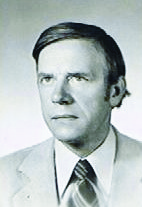Title of the work
Country of the First Edition
Country/countries of popularity
Original Language
First Edition Date
First Edition Details
Franciszek, Kobryńczuk, “Arachne”, Biuletyn Północno-Wschodniej Izby Lekarsko-Weterynaryjnej [Bulletin of the North-Eastern Veterinary Chamber ] 57.3 (2015): 93–94, (accessed: September 21, 2022).
ISBN
Available Onllne
Arachne at ewa.bicom.pl (accessed: September 21, 2022).
“Arachne”, Biuletyn Północno-Wschodniej Izby Lekarsko-Weterynaryjnej 57.3 (2015): 93–94, (accessed: September 21, 2022).
Genre
Narrative poetry
Poetry
Target Audience
Children
Cover

We are still trying to obtain permission for posting the original cover.
Author of the Entry:
Maciej Skowera, University of Warsaw, mgskowera@uw.edu.pl
Peer-reviewer of the Entry:
Katarzyna Marciniak, University of Warsaw, kamar@al.uw.edu.pl
Elżbieta Olechowska, University of Warsaw, elzbieta.olechowska@gmail.com

Photograph courtesy of the Author.
Franciszek Kobryńczuk
, 1929 - 2016
(Author)
A veterinarian, professor of veterinary sciences specializing in animal anatomy (an authority on the anatomy of the Polish bison), writer, and poet. 1948–1950: a member of a secret youth organization active within the post-WW2 underground connected to Armia Krajowa [Home Army], banned by the Communist regime; in 1950 he was sentenced to a 10-year prison term for this activity; fully exonerated after the fall of Communism. Graduated from the Faculty of Veterinary Medicine of the Warsaw University of Life Sciences (SGGW); from 1994 to 2000 Head of the Department of Animal Anatomy at the same University. Debuted as an author for children in 1958 with a short poem Sowa [Owl], published in children’s magazine “Miś”; contributor to several other magazines for children and young adults, such as “Świerszczyk,” “Płomyk,” “Płomyczek,” and “Mały Apostoł”; author of about 30 books for children, young adults and adults; a former member of the Polish Writers’ Union; now his poems can be found most of all online. The page ewa.bicom.pl/wierszedzieci run by a Kobryńczuk’s admirer, Ewa Białek, functions as the official website for Kobryńczuk’s poems for children.
Source:
Materials kindly provided by the Author.
Bio prepared by Maciej Skowera, University of Warsaw, mgskowera@gmail.com
Summary
Based on: Katarzyna Marciniak, Elżbieta Olechowska, Joanna Kłos, Michał Kucharski (eds.), Polish Literature for Children & Young Adults Inspired by Classical Antiquity: A Catalogue (accessed: June 11, 2021), Faculty of “Artes Liberales”, Warsaw: University of Warsaw, 2013, 444 pp.
A mortal woman named Arachne boasts that she is a better weaver than Athena. In response, the goddess orders Arachne to demonstrate her skills. When Athena realizes that Arachne’s skills are indeed exceptional, she falls into a rage, destroys the woman’s work and attacks her with a shuttle. In despair Arachne commits suicide. Athena comes to her senses and brings Arachne back to life by transforming her into a spider.
Analysis
Interestingly, the author completely omits the issue of Athena’s embroidered didactic image of the Olympian gods with examples of the punishments that can befall people for their hubris. Instead, the writer focuses entirely on the fabric made by Arachne, showing the gods entering into amorous relationships with mortals. This can be read as a dedication of the entire poem, not to the Greek goddess, but to the woman who was transformed into a spider. The work may be interpreted as a story of human suffering (moreover, there is a passage in the poem about Athena’s physical attack on Arachne and her subsequent suicide). The ending, however, goes beyond the pattern of a tale of guilt and punishment. As Athena gives Arachne a fate focused on weaving beautiful “compositions of webs, of dewdrops, of the colours of the sun,”*; she tells her that they are to divide the space of the forest into “chambers that “the poets will give to all artists for free.” The retelling thus becomes a poetic statement about poetry itself and, more broadly, about artistic creation, the genesis of which may lie in pain, suffering, and sacrifice.
* All quotations translated by Maciej Skowera.
Further Reading
Mapel Bloomberg, Kristin M., Tracing Arachne’s Web: Myth and Feminist Fiction, Gainesville: University Press of Florida, 2001.
Miller, Nancy K., “Arachnologies: The Woman, the Text, and the Critic” in Subject to Change: Reading Feminist Writing, New York Chichester, West Sussex: Columbia University Press, 1988, 77–101.
Nosek, Anna, W przestrzeniach universum i regio. Wiersze dla dzieci współczesnych pisarzy regionu podlaskiego – interpretacje [In the Spaces of universum and regio: Poems for Children by Contemporary Writers of the Podlasie Region – Interpretations], Białystok: Wydawnictwo Uniwersytetu w Białymstoku, 2015.
Addenda
In Ancient Greek, ἀράχνη [arákhnē] means ‘spider,’ which is used in taxonomical nomenclature for both plants (e.g., the genus Arachnis) and animals (e.g., the class Arachnida).
Before the print publication, the poem has been available online, at Ewa Białek’s website.


